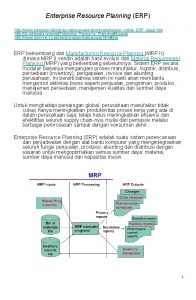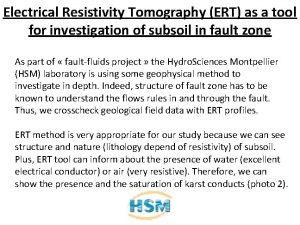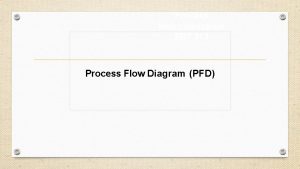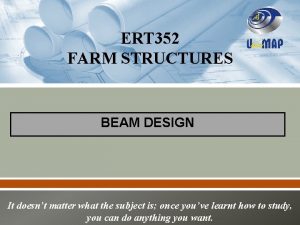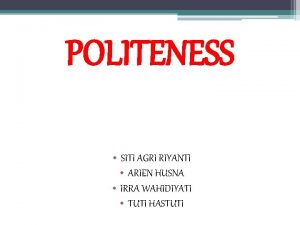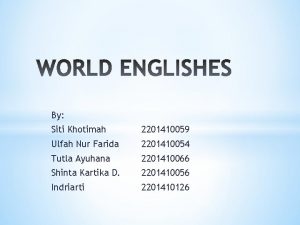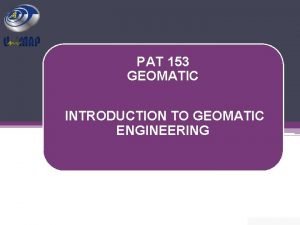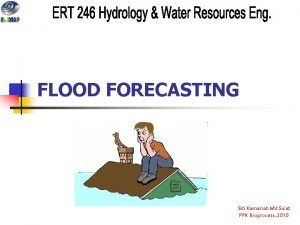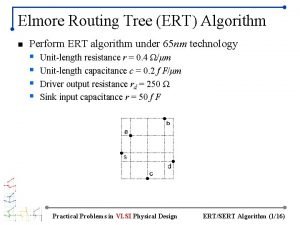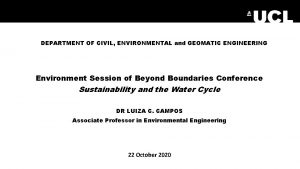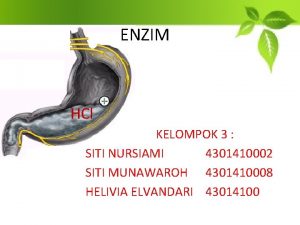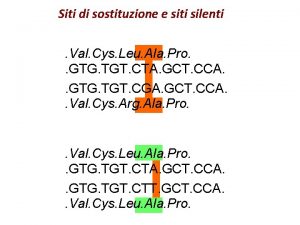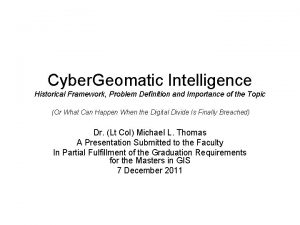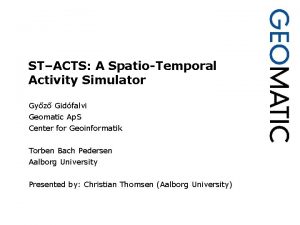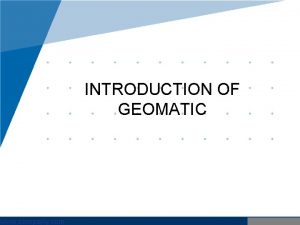ERT 252 GEOMATIC ENGINEERING MRS SITI KAMARIAH MD
































- Slides: 32

ERT 252 GEOMATIC ENGINEERING MRS SITI KAMARIAH MD SA’AT LECTURER BIOSYSTEMS ENGINEERING/ AGRICULTURAL ENGINEERING Email: sitikamariah@unimap. edu. my Phone: 019 -5706232

DISTANCE MEASUREMENT

Introduction • One of the fundamentals of surveying is the need to measure distance. • Distances are not necessarily linear, especially if they occur on the spherical earth. • In this course we will deal with distances in geometric space, which we can consider a straight line from one point or feature to another.

Distance Measurements • Distance between two points can be horizontally, slope or vertically recorded in feet/meters. • Horizontal and slope distance can be measured using fibreglass tape/steel tape/using electronic distance measuring device. • Vertical distance can be measured using a tape, as in construction work, with a autolevel and staff. It also can be determine by trigonometry.

Slope, Vertical and Horizontal Distances

Distance Measurements

Distance Measurement Equipment

ELECTRONIC DISTANCE MEASUREMENT (EDM) • EDM is very useful in measuring distances that are difficult to access or long distances. • It measures the time required for a wave to sent to a target and reflect back.

Taping (or chaining) • Taping is applied to measurement with a steel tape or synthetic tape (plastic or fiberglass). • All standard in lengths • 100 m, 50 m, 30 m, 20 m. • It is fairly quick, easy and cheap, and hence is the most common form of distance measurement.

Taping (or chaining) • Unfortunately, taping is prone to errors and mistakes. • For high accuracy, steel tape should be used which is graduated in mm and calibrated under standard temp (20 degree) and tension (5 kg). Be careful, easily break. • Synthetic tape is more flexible graduated in 10 mm


Taping on smooth level/sloping ground • • Tape must always be straight Tape must not be twisted Use chaining arrows for intermediate points Tape horizontally if possible Tape on the ground if possible Slope taping needs to be reduced Catenary taping requires correction Step taping suits some applications

Tape must be straight… ce n a ist d obstruction r ir u q e e st i d c an ed ed sur a e m measured distance required distance

For very long distance

For very long distance Length AB = 4 x Full tape distance + 1 Short section REMEMBER ! It works only on smooth ground or uniform slope surfaces

Use chaining arrows… nce a t is d st di e c an d e ur s ea uired m req measured distance required distance

Sloping Ground Measurement

Slope Measurement

Sources of Error in Taping • Instrumental errors • actual length can be different from nominal length because of a defect in manufacture or repair on as a result of kinks. • Natural errors • the horizontal distance of a tape varies because of effects of temperature, wind and weight of tape itself. • Personal errors • Tape persons may be careless in setting pins, reading tape or manupulating equipment.

Taping Errors Typical taping errors: • Incorrect length of tape • Temperature other than standard Systematic Taping Errors Random Taping Error 1. Slope 2. Standardization length 2. Temperature 3. Tension and Sag 4. Tension & Sag 4. Alignment 5. Marking & Plumbing

Taping Corrections • For synthetic tapes, only Standardized Tape Length correction and Slope corrections will be applied • The best accuracy that can be achieved is the order of 1: 1000 • When using steel tapes, if only Standardized Tape Length and slope corrections are considered, the best possible accuracy that can be obtained in the range 1: 5000. • If tension and temperature added into consideration, accuracy can be increased to better than 1: 10000 ~ 1: 20000 • Sag only applies if tape is supported only at ends

Standard Length Correction Where Ca = correction of absolute length C = correction to be applied to the tape= l’-l L= measured length l’= standardized length of field tape l = nominal length of the tape • Example: A distance of 220. 450 m was measured with a steel band of nominal length 30 m. On standardization the tape was found to be 30. 003 m. Calculate the correct measured distance, assuming the error is evenly distributed throughout the tape. • • Error per 30 m, C = 3 mm Correction for total length = = 220. 45(0. 003)/30 =0. 022 m • Correct length is 220. 450 + 0. 022 = 220. 472 m

Slope Correction OR L(1 - cosθ) • Consider a 50 -m tape measuring on a slope with a difference in height of 5 m. The correction for slope is = – 25/100 = – 0. 250 m

Tension correction • E is modulus of elasticity of tape in N/mm 2 = 2. 0 x 105 N/mm 2 for steel • • • A is cross-sectional area of the tape in mm 2 L is measured length in m; and Po is the standard pull P is pull applied during measurement As the tape is stretched under the extra tension, the correction is positive. If less than standard, the correction is negative.

Tension correction • Consider a 50 -m tape with a cross-sectional area of 4 mm 2, a standard tension of 50 N and a value for the modulus of elasticity of E = 200 k. N/mm 2. Under a pull of 90 N the tape would stretch by

Temperature Correction • Where Tf = mean field temperature during measurement • Ts = temperature of standardization • Coefficient of expansion of steel α = 0. 0000112 per °C for steel • If L = 50 m and the different of temperature and standard temperature (20 o. C) in temperature is 2°C then Ct = 0. 0000112 x 50 (± 2 -20) = -0. 0010 m

Sag correction

For converting slope distances L to horizontal distances D: D = L – slope± standardization ± tension ± temperature – sag Eq. (4. 8) For vertical measurements V: V = VM ± standardization ± tension ± temperature Eq. (4. 9) where VM = measured vertical distance Summary

EXAMPLE 1: Measuring a horizontal distance with a steel tape • A steel tape of nominal length 30 m was used to measure the distance between two points A and B on a structure. The following measurements were recorded with the tape suspended between A and B: Line Length measured applied AB N • • 29. 872 m Slope angle 3° 40’ Mean temperature Tension 5 °C 120 The standardized length of the tape against a reference tape is 30. 014 m at 20 °C and 50 N tension. The tape weighs 0. 17 N m– 1 and has a crosssectional area of 2 mm 2. Calculate the horizontal length of AB.

• Answer From equation (4. 1): slope correction = L (1 -cosθ) = – 29. 872 (1 – cos 3° 40') = – 0. 0611 m • From equation (4. 3): standardization correction , =29. 872 (30. 014 -30)/30 = +0. 0139 m • From equation (4. 5): tension correction, = 29. 872 (120 -50)/(2 mm 2 x 200000 N/mm 2) = +0. 0052 m • From equation (4. 6): = 0. 0000112 x 29. 872 (5 -20) temperature correction = = – 0. 0050 m • From equation (4. 7): sag correction • • = = – 0. 0022 m Using equation (4. 8): Horizontal length AB = 29. 872 -0. 0611 +0. 0139+0. 0052 -0. 0050 -0. 0022 = 29. 823 m (to the nearest mm)

EXERCISE IN TEXTBOOK (Surveying for Engineers, Uren) • 4. 6 • 4. 7 • 4. 8

Thank You
 Ert erp definition
Ert erp definition Ert tool
Ert tool Ert 1 programa
Ert 1 programa Ert diagram
Ert diagram Ert products malaysia
Ert products malaysia Pt = p.ert merupakan rumus dari pertumbuhan penduduk
Pt = p.ert merupakan rumus dari pertumbuhan penduduk Ert erp definition
Ert erp definition Ert uniform design
Ert uniform design Transfer function of pid controller is
Transfer function of pid controller is They are mrs garcia and mrs castro
They are mrs garcia and mrs castro They are mrs garcia and mrs castro
They are mrs garcia and mrs castro Mrs. darling was ___________ of mrs. s.
Mrs. darling was ___________ of mrs. s. Ve čtvercové síti je umístěn rovnoběžník abcd
Ve čtvercové síti je umístěn rovnoběžník abcd Nebezpečí sociálních sítí prezentace
Nebezpečí sociálních sítí prezentace Semi structured interview questions
Semi structured interview questions Až chlapečku zavřeš víčka
Až chlapečku zavřeš víčka Jenis susunan ayat
Jenis susunan ayat Syair siti sianah
Syair siti sianah Siti sarah
Siti sarah 1800 dam per jam berapa hm per menit
1800 dam per jam berapa hm per menit Schéma bytové rozvodnice
Schéma bytové rozvodnice Siti chuzaemi
Siti chuzaemi Siti rohaida
Siti rohaida Tact maxim examples
Tact maxim examples Siti karimah
Siti karimah Qui se laudari gaudet verbis subdolis
Qui se laudari gaudet verbis subdolis Bendera siti fatimah
Bendera siti fatimah Siti khotimah
Siti khotimah Eko siti
Eko siti Siti aisyah binti akiah
Siti aisyah binti akiah How to simplify square roots
How to simplify square roots Cs 252
Cs 252 Chapter 252 florida statutes
Chapter 252 florida statutes
